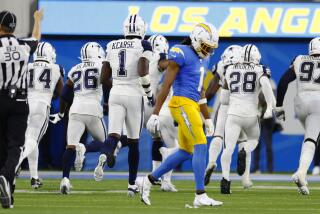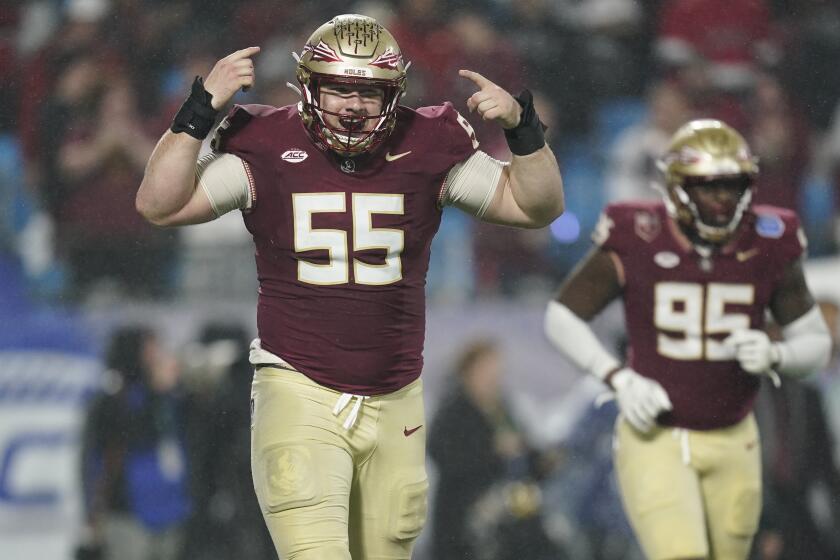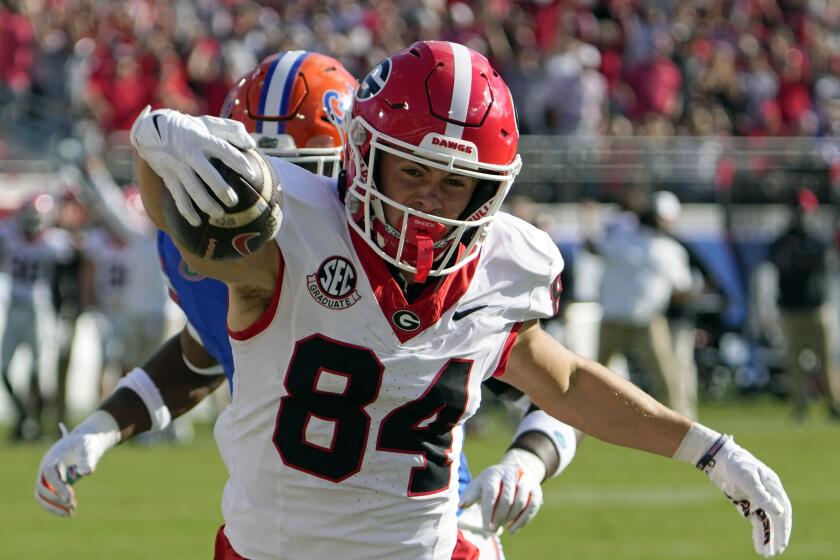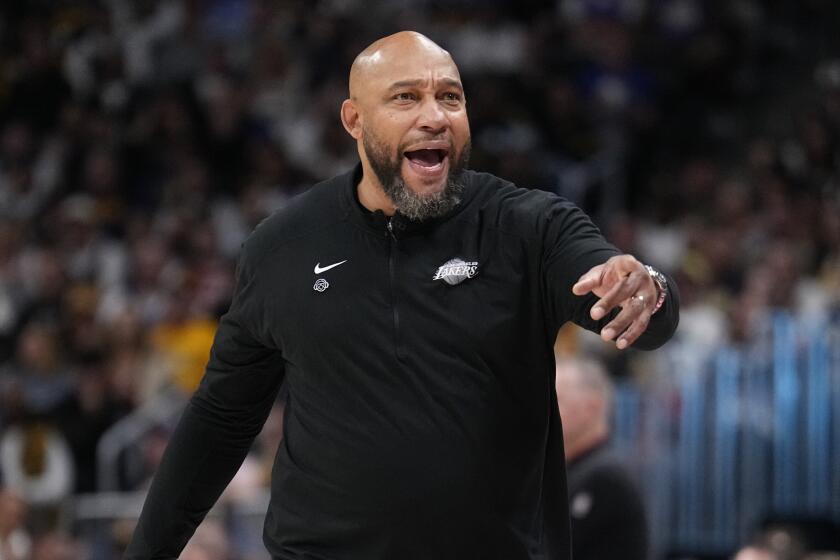Q&A: For Cowboys owner Jerry Jones, taking risks has paid off
In the NFL, everyone tries to keep up with the Joneses.
And for good reason.
Dallas Cowboys owner Jerry Jones has transformed a franchise that was losing $1 million per month in 1989, into the league’s richest team, one valued by Forbes at $1.8 billion. Despite their struggles on the field, the Cowboys are routinely at the top when it comes to number of prime-time games, sponsorship revenue, TV viewership numbers, and merchandise sales. In fact, their cheerleaders even outsell many NFL teams in merchandise.
The Cowboys’ $1.3-billion stadium is the most luxurious and largest this country has ever known.
Even with the on-field success of such teams as the New England Patriots, Indianapolis Colts, New Orleans Saints and Green Bay Packers, the Cowboys are still called “America’s Team,” despite going a club-record 15 seasons without a Super Bowl appearance. Since winning three Super Bowls in Jones’ first five years of ownership, the Cowboys have recorded two playoff victories.
At his Valley Ranch office in Irving, Texas, Jones recently met with Los Angeles Times NFL writer Sam Farmer for a lengthy interview on a wide range of topics, from the risk he took in buying the team, to his friendship with late Oakland Raiders owner Al Davis, to the future of the NFL in L.A.
Why was buying the Cowboys such a risk?
At the time, we had had two flat television negotiations in the NFL. The NBA was booming. Talk of maybe becoming more popular than the NFL. I bought 13% of the team from the government because it had been foreclosed on. It was losing a million a month in cash flow. And I paid more for it than had ever been paid for anything in the history of sports. About $154 million.
Did you have any second thoughts?
The first time I came down with an eye to buy the team, the owner at the time, Bum Bright, had Roger Staubach sit with me, [my wife] Gene and [our daughter] Charlotte, and we watched the Cowboys play a home game against the Giants.
On one side of the field was Bill Parcells. On the side I was on, you had Tom Landry with the Cowboys. Thirty-two thousand people were there — 32,000! And just to make sure that I could handle it, I went down in the fourth quarter and sat in the stands. The stadium couldn’t sell beer and liquor, but they let coolers come in. So people had beer and liquor in coolers. So I was sitting there, with 80,000 beer cans on the floor, whiskey bottles everywhere. They were just remnants of the people that were there. I just wanted to sit there and see how it would feel if I had made that commitment, to see if I could handle those conditions. I must have thought I could, because I bought the team.
What was the economy like in Texas at the time?
It looked like a nuclear bomb had gone off here. There were things around this town that were selling for a nickel on the dollar for what had been loaned against it three and four years earlier. A nickel. Because nothing could move, nobody could borrow any money, and only cash talked. If it hadn’t been that way, the opportunity to buy the Cowboys wouldn’t have been there.
Now, 22 years later, are you more risk averse?
No. Just look at our new stadium. I thought I’d danced with the devil when I bought it and lived to tell about it, and then turned right around and was 50 feet in the ground when we had the worst economic hit of anyone in our lifetime. That’s not risk aversion.
The NFL would be taking a risk, wouldn’t it, in returning to the Los Angeles market? What’s the appetite for that?
Our interest in Los Angeles is at the highest levels of any kind of measurement that you want to measure. Right now. We in the NFL unquestionably are in sports and competition, but we’re also in entertainment, and that’s the entertainment capital of the world. It just bowls you over when you see the opportunity in L.A.
You have said before that the NFL cannot become a “studio game,” and be better to watch on TV than in person. What kind of challenge does that present, even with the giant video board at your stadium?
Television has always been our No. 1 competition. But I know firsthand that you can create an experience you can’t get on television. I also know that the social experience has an appeal. When you come to our stadium and look at the aura of 100,000 people. You look up there and see an Army tank coming at you. You see it on a TV screen it’s one thing. You see it at a movie theater that’s something else. When that thing’s coming at you 70 feet high and 180 feet long, now that looks like a tank.
Why don’t you have a naming rights deal for your stadium yet?
We’re being very selective. I never had naming rights at Texas Stadium. Because in our case, when we put a name on that stadium, we will name the Cowboys. It’s almost going to be like the Pepsi Cowboys. It will be that dominant. We have great relationships with other services and brands that the benchmark for what the naming right would be has to be so special — not just dollars, but it has to fit the Cowboys. Because this stadium is arguably one of the most visible buildings in the United States, and will get more so as time goes along.
Because of the lockout, the free-agency period was compressed and held just before the start of training camps. That created an exciting week of activity. Would the league consider making that change permanent?
I liked it condensed. The league is very aware that that created a bonus interest with fans that hadn’t been anticipated. You couldn’t have anticipated that. We should look at that, and I wouldn’t dismiss it.
Any memorable exchanges with Al Davis?
He’d come down to Dallas and bring the Raiders to practices in Dallas. He saw what we were doing with our practices. He had some memorabilia trailers built with Raiders on them and said, “Could I bring them down and put them right out in the middle of the Cowboy crowd?” I said, “Come on! Let’s do it!”
So we’d be walking along out at practice, watching drills but talking. He was healthy feeling, feeling strong and good. He’d say, “You’re just so urgent in your practices. So urgent. The word is urgent. I want the Raiders to be this urgent.” And then he stops and says, “OK, that’s enough on that drill, guys. Stop. We don’t want to get somebody hurt. That’s about as far as we need to go.” This is a drill with both Raider and Cowboy coaches. So they look at each other and stop the drill.
Then we start walking and I said, “Al, you just told me you wanted to be urgent and get it going. A part of that is being physical, hearing it pop a little bit. How the hell can you be urgent if you’re going to walk around and stop all the drills?”
He was famous for calling at all hours of the night. Did he do that with you?
Yes, he was all over the map. He called here after our first year [when the Cowboys finished 1-15] and said, “Jerry, you had a bad season, but you didn’t lose the team. I saw some good things out there.”
I listened to him a little bit longer and then I said, “Al, I’ve burned my bridges. Burned ‘em behind me. Burned the boats. I’m not going anywhere at all. It sounds like you’re trying to keep me from leaving. I couldn’t leave if I wanted to.
“I’ve got to make this go, or I’ll never be able to do anything.”
More to Read
Get our high school sports newsletter
Prep Rally is devoted to the SoCal high school sports experience, bringing you scores, stories and a behind-the-scenes look at what makes prep sports so popular.
You may occasionally receive promotional content from the Los Angeles Times.







